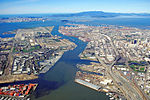Naval Air Station Alameda
Airports in the San Francisco Bay AreaBuildings and structures in Alameda, CaliforniaClosed installations of the United States NavyDefunct airports in CaliforniaHistory of Alameda County, California ... and 9 more
History of the San Francisco Bay AreaMilitary Superfund sitesMilitary facilities in the San Francisco Bay AreaMilitary installations closed in 1997National Register of Historic Places in Alameda County, CaliforniaSuperfund sites in CaliforniaTransportation buildings and structures in Alameda County, CaliforniaUnited States Naval Air StationsWorld War II on the National Register of Historic Places in California

Naval Air Station Alameda (NAS Alameda) was a United States Navy Naval Air Station in Alameda, California, on San Francisco Bay.NAS Alameda had two runways: 13–31 measuring 8,000 ft × 200 ft (2,438 m × 61 m) and 07-25 measuring 7,200 ft × 200 ft (2,195 m × 61 m). Two helicopter pads and a control tower were also part of the facilities.
Excerpt from the Wikipedia article Naval Air Station Alameda (License: CC BY-SA 3.0, Authors, Images).Naval Air Station Alameda
Airfield Perimeter Road,
Geographical coordinates (GPS) Address External links Nearby Places Show on map
Geographical coordinates (GPS)
| Latitude | Longitude |
|---|---|
| N 37.786111111111 ° | E -122.31861111111 ° |
Address
NAS Alameda (abandoned)
Airfield Perimeter Road
94110
California, United States
Open on Google Maps








